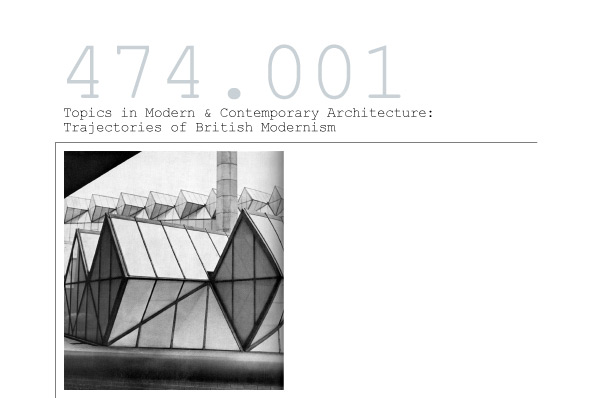
The seminar considers a series of shifting contexts for British architecture together with increasingly fluid transmissions between British architects, Continental modernists, and a shrinking colonial empire. From an early embrace of modern building during the Industrial Revolution (culminating in the Crystal Palace), Britain then shrank from a blatantly technological modernity until the conclusion of World War II, when a doctrinaire, economically constrained version of European functionalism swept the British scene as a result of postwar building needs and ideological affinities. The particular efforts of the prewar MARS group of Morton Shand (aided by the arrival of Walter Gropius, Erich Mendelsohn, Arthur Korn, Laszlo Moholy-Nagy, Berthold Lubetkin and others in the 1930s) were dramatically eclipsed after the war by the London County Council and other local building authorities that produced a reduced and bureaucratized (and often poorly constructed) modernism against which architects of the late 1950s reacted with militant iconoclasm. Returning to the sources from which British architects learned of Continental modernism (Le Corbusier's Oeuvre Complete (1935-) and Alberto Sartoris's Gli elementi dell'architettura funzionale (1935) among others), young architects trained in the immediate aftermath of the war resumed the incomplete project of modernism with pioneering ambition. Organized by a variety of institutions-the ICA, CIAM's Team X, Gordon Cullen's townscape movement, the Architectural Association, and Reyner Banham, to name a few-a new architecture emerged from the work of the Smithsons, Archigram, Cedric Price, Stirling + Gowan, Fry and Drew, and others. Skirmishes with Italy's 'neo-Liberty' (neo-Realist) architects in the late 50s and 60s left Britain victoriously leading a neo avant-garde that avoided the pitfalls of American corporate modernism without relinquishing the project of an integrated, progressive, multi-disciplinary modern culture in which architects, artists, urban planners, and social scientists worked side by side. Banham's 'Second Machine Age' helped create the emergent group of techno-architects who went on to mastermind the most recent wave of British cultural imperialism: Stirling, Richard Rogers, Norman Foster, Ove Arup, and Nicholas Grimshaw. The course will conclude with the contemporary British scene as represented by David Chipperfield, David Adjaye, and young collectives like FAT (Fashion Architecture Technology). Open to advanced undergraduates and graduate students. Estimated cost for materials: $50 or more, but less than $100. IV.4'
Instructor: Claire Zimmerman
email:zimclair@umich.edu
email:zimclair@umich.edu
- Tuesday *Meets with ARCH 503.001
- 10:00am - 1:00pm
- G-026 Tisch
- Credits: 3
- Seminar